Rocket Roundup includes two long-delayed Chinese launches that finally go up along with another surprise Chinese launch, Russia launches a space station resupply, and Japan launches nine small satellites. Plus, this week in rocket history, we look back at the first ISS Expedition.
Podcast
Show Notes
Chinese smallsat launcher
- CCTV News
- Jilin-1 info page (Chang Guang Satellite Technology Co., Ltd) (Chinese)
- Kuaizhou-1A info page (Gunter’s Space Page)
Russian Progress spacecraft brings 1.5 tons of supplies, propellant to ISS
- Roscosmos press release (Russian)
- BIOMAG-M info page (Tsniimash) (Russian)
- Docking press release (Roscosmos) (Russian)
- The ISS temporarily isolated a compartment from which air leaks (RIA) (Russian)
- Launch video
Chinese rocket launches military satellites
- China launches new remote sensing satellites (Xinhua)
- Yaogan 32-01 info page (Gunter’s Space Page)
- Launch video
China launches earth observation satellite
- Xi’an Aerospace press release (Chinese)
- Long March-6 info page (Gunter’s Space Page)
- Launch video
Small Japanese rocket launches technology demonstration satellites
- JAXA press release (Japanese)
- Innovative satellite technology demonstration No. 2 (JAXA) (Japanese)
- Epsilon info page (Gunter’s Space Page)
- Launch video
This Week in Rocket History: ISS Expedition 1
- First crew starts living and working on the International Space Station (ESA)
- Cargo spacecraft “Progress M1-4” (Kursknet via Internet Archive)
- International Space Station Status Report #63 (NASA via Internet Archive)
- Gateway to Astronaut Photography of Earth (NASA)
- Plasma Crystal info page (MPE via Internet Archive)
- STS-97 (NASA)
- STS-98 (NASA)
- STS-102 (NASA)
Transcript
Hello, and welcome to the Daily Space. My name is Erik Madaus, filling in for Annie Wilson while she takes a well-deserved vacation. I’ve been behind the scenes as one of the show’s writers, and I appreciate this chance to present my words.
Most weekdays the CosmoQuest team is here putting science in your brain.
Today, however, is for Rocket Roundup.
Let’s get to it, shall we?

First up, on October 27 at 06:19 UTC, a Chinese Kuaizhou 1A launched the Jilin-1 Gaofen 02F commercial imaging satellite into sun-synchronous orbit from the Jiuquan Satellite Launch Center in China.
Jilin-1 Gaofen 02F is a high-resolution, optical imaging satellite sensitive to visible and near-infrared wavelengths. It is capable of 75-centimeter ground resolution in panchromatic mode, with a better than 40-kilometer image width. At this resolution, the satellite can capture clear images of things like roads, driveways and cars.
The Kuaizhou 1A is a four-stage launch vehicle developed from the two-stage solid DF-21 road-mobile medium range ballistic missile first deployed in 1991, with one additional solid stage and a liquid propellant fourth stage to turn it into a space launch vehicle capable of putting 400 kilograms into orbit. Like the ballistic missile it is derived from, the rocket is launched from the back of a transporter truck parked and set up on a concrete pad.
Jilin-1 Gaofen 02F replaces Jilin-1 Gaofen 02C which was lost in a failed Kuaizhou 1A launch last year.
Next up, on October 28 at midnight UTC, a Russian Soyuz 2.1a rocket launched the Progress MS-18 spacecraft towards the International Space Station. This was the 1,949th launch of an R7-derived Soyuz since its first over 64 years ago.

Onboard the craft was 1,480 kilograms of equipment, which is about the mass of two cows. This included five scientific experiments for the Russian cosmonauts to perform, 560 kilograms of propellant to be used for boosting the ISS’s orbit, 420 kilograms of drinking water, and 43 kilograms of compressed oxygen to refresh the supply on the Russian segment.
The five experiments included Matryoshka-R, which uses analogs for both living tissue and station components and measures the accumulated radiation dose on both of those things. It also measures the radiation environment around the station.
Biomag-M will study whether a magnetic field can protect living things from the harshness of outer space with the goal of creating microorganisms that are more resistant to spaceflight.
Aseptic will investigate methods for sterilizing equipment on the station.
Structure is a protein crystallization experiment designed to produce large crystals for the production of medicine, science, and other fields. They will be returned to Earth for analysis. Several iterations of both this experiment and Aseptic have flown before, going back several years.
After a leisurely two days of catching up with the ISS, Progress MS-18 successfully docked autonomously to the back port of the Zvezda module on Saturday, October 30. After several hours of leak checks, the hatch from the station to the spacecraft was opened. These leak checks have always been standard procedure, but since the discovery of a series of cracks in the Zvezda module’s docking compartment in 2019, they are much more important. Progress will stay at the station, providing occasional re-boost burns as needed until it departs for a destructive reentry in the South Pacific in Spring 2022.
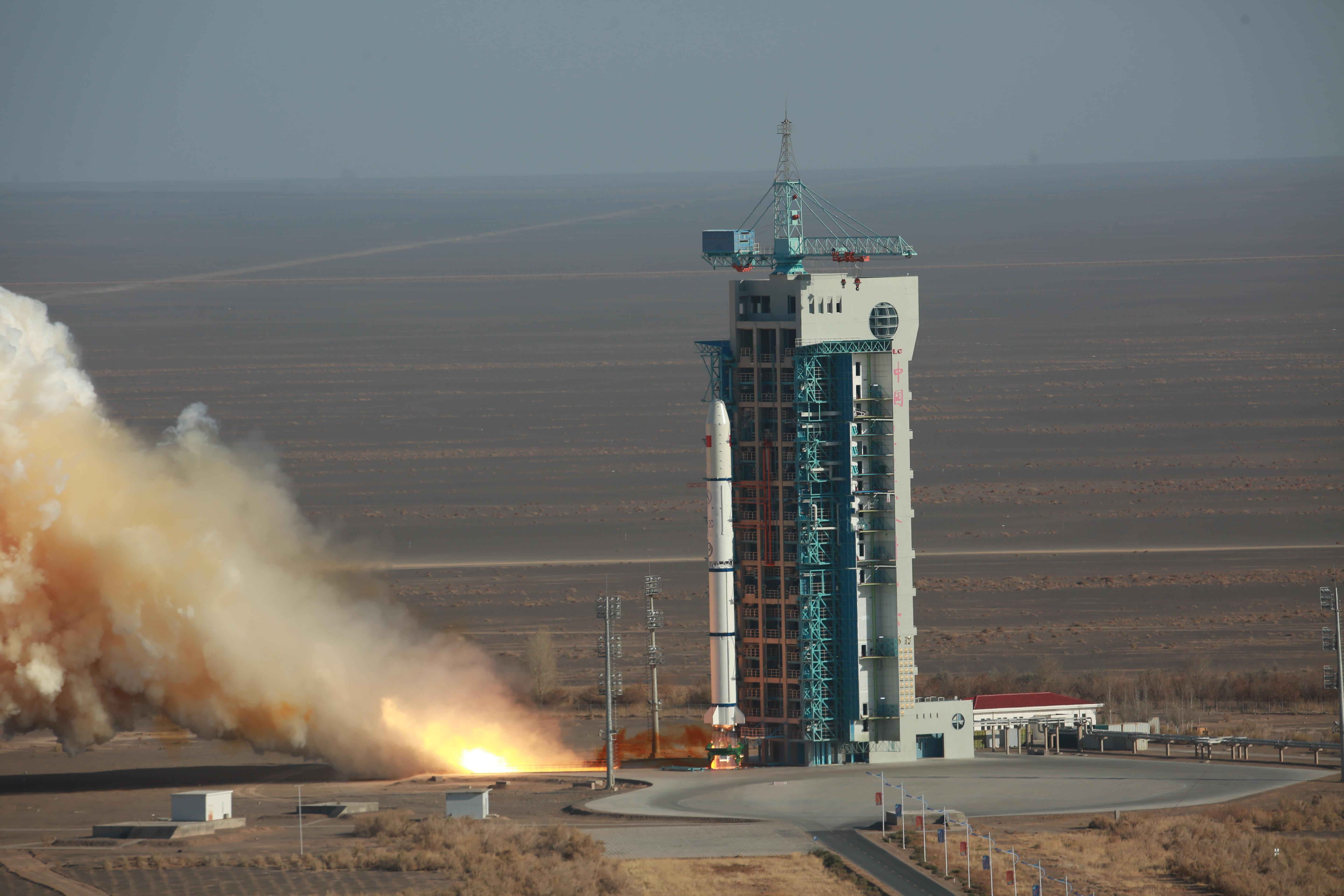
Next up, on November 3 at 07:45 UTC, a Chinese Long March 2C launched the second pair of Yaogan 32 satellites into orbit from the Jiuquan Satellite Launch Center.
The satellites’ mission was not officially disclosed, but a launch animation did show many antennas on the satellite. This suggests that it could potentially have a signals intelligence mission, where the satellites collect transmissions from other countries’ equipment such as radars and communications antennae to determine their capabilities.
This rocket again used a Yuǎnzhēng 1S upper stage to put the satellites in the intended orbit, like the RSW launch we covered on August 25. This was the third flight of this particular variant of the YZ-1 upper stage optimized for the Long March 2C. The launch was previously expected for this past month but was delayed until late October for unknown reasons.
China launched 3 more Yaogan satellites, the Yaogan 35 triplet, on November 6 at 0300 UTC, on a Long March 2D from Xichang. No details about the satellites were released.

On November 5 at 02:19 UTC a Chinese Long March 6 launched the SDGSAT-1 Earth observation satellite into a sun-synchronous orbit from the Taiyuan Satellite Launch Center in China.
SDGSAT-1, also called Guangmu or “Wide Eye”, is an earth science satellite developed to support the United Nations Sustainable Development Goals for 2030, according to the Xi’an Aerospace Power Research Institute. It has three instruments: a thermal infrared sensor, a low light sensor, and a multispectral imager with a swath width of 300 kilometers. This impressive imager gives it the ability to record the entire Earth every eleven days, looking for signs of human impact on the environment in support of the goals.
The Long March 6 is a relatively new Chinese rocket, and this was only its eighth launch since its first launch in 2015. The Long March 6 is the smallest member of the new generation of Long March rockets which includes the Long March 5, 6, 7, and 8. These newer rockets are designed to use nontoxic and higher performing Rocket Propellant 1 (RP-1) and Liquid Oxygen (LOX) in all stages instead of the very stable but super toxic Unsymmetrical Dimethyl Hydrazine and Nitrogen Tetroxide. RP-1 and LOX require special handling both on the ground and in the rocket to prevent problems, like the oxygen boiling off and the pressure rupturing the rocket’s tank. The Long March 6 can put up to 1,080 kilograms into a sun-synchronous orbit.
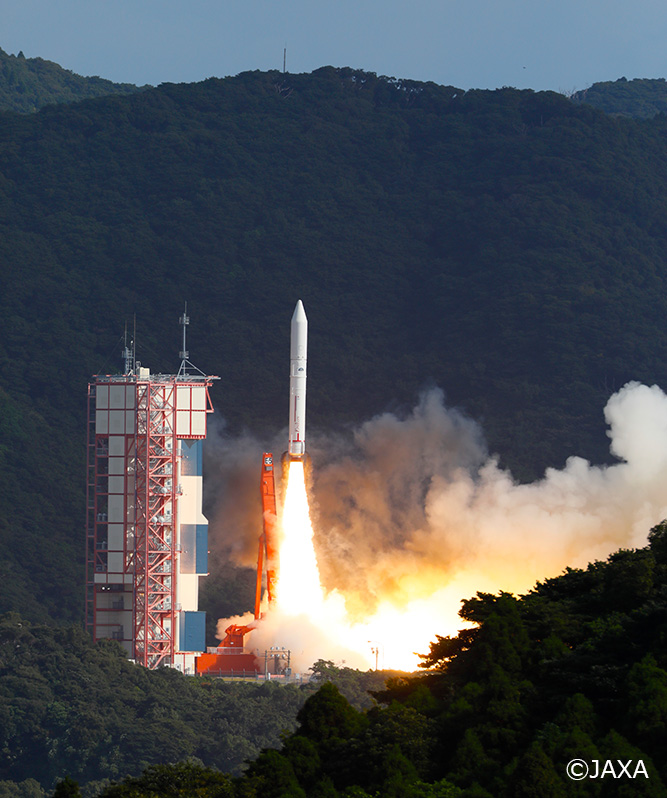
On November 9 at 00:51 UTC a Japanese Epsilon 2 rocket launched the RAISE-2 technology demonstration satellite and eight other satellites of various shapes and sizes from the Uchinoura Space Center in southern Japan.
The Epsilon 2 is a three- or four-stage rocket using three solid stages from the H-II and Mu-V rockets, with an optional liquid-propellant fourth stage to increase payload to orbit and insertion accuracy. This flight used a liquid fourth stage. The launch was delayed several times from last month due to a problem with the ground, the vehicle, the weather, and the need to use range assets for another launch.
This was only the fifth launch of an Epsilon rocket since its first launch in 2013. It is designed to put payloads up to 500 kilograms into a 700-kilometer orbit as it did with this mission. It replaced the Mu-V rocket which was retired in 2006.
RAISE-2 is the main payload on the flight. It is a 110-kilogram small satellite which hosts several small payloads, including a new kind of low-power, space-rated microcomputer designed by Sony, a new fiber-optic gyroscope, a commercial off-the-shelf star tracker, a 3D printed antenna, and an inertial measurement unit.
HIBARI is a 50-kilogram microsatellite which will test using solar array paddles to provide the torque to move a satellite. Reaction wheels and control moment gyroscopes are currently used to control satellite attitude, but it is very difficult to get both accuracy and stability using these systems. HIBARI also has a small ultraviolet telescope to take advantage of and confirm the pointing accuracy, hoped to be less than ten arcseconds.
Z-Sat is a 46-kilogram satellite that will take images of the ground in both near- and far-infrared and combine them for better observation of heat sources. It is expected to be the first of a constellation of such satellites.
DRUMS (Debris Removal Unprecedented MicroSatellite), a 62-kilogram smallsat, will test orbital debris removal technologies.
Teikyosat-4 will be used to provide really fine microgravity for life science and materials science applications where crewed space stations provide too much disturbance. It weighs 52 kilograms and is developed by Teikyo University.
ASTERISC has a large deployable sheet that will be used as a dust and/or space debris sensor. It is designed to be low-cost, so it was integrated into a three-unit CubeSat the size of a loaf of bread and only weighs four kilograms.
There are three other CubeSats that Patrons can read about in this week’s bonus material.
This Week in Rocket History
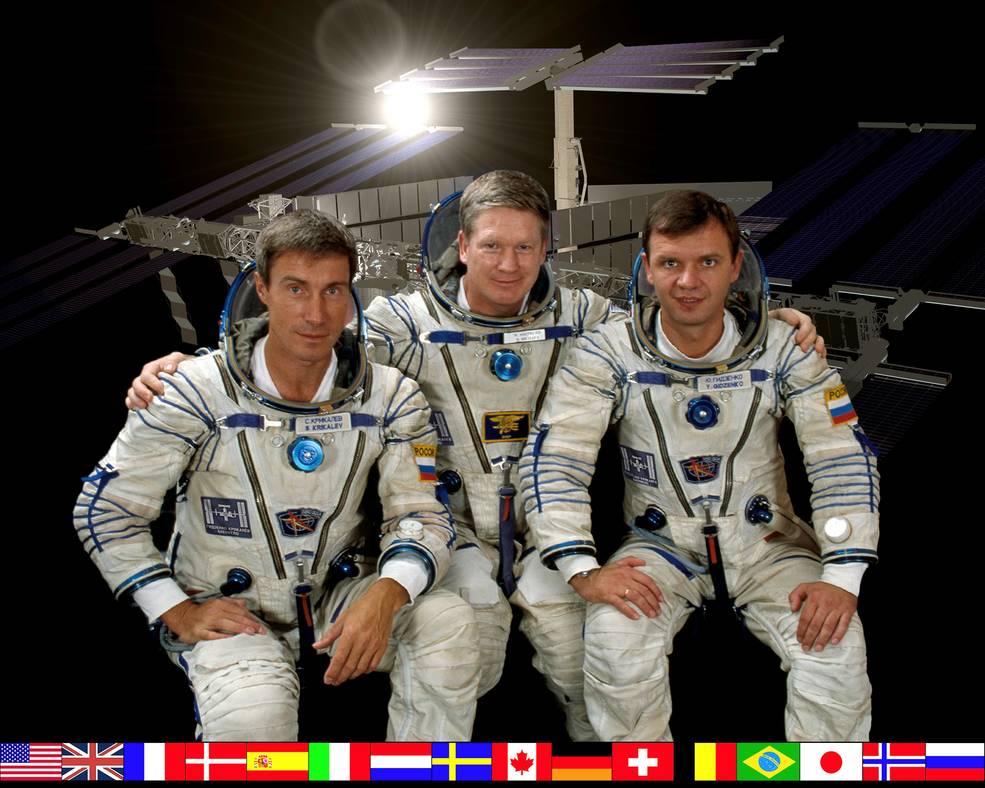
This Week in Rocket History: the first International Space Station expedition.
The first module of the International Space Station had been launched all the way back in 1998, but over the next two years, no crew had spent more than a handful of days at the station. Crews went up, did a bit of work putting the station together, and then left it mothballed.
That changed on October 31, 2000, with the launch of Soyuz TM-31. Onboard were NASA astronaut William Shepherd and Russian cosmonauts Yuri Gidzenko and Sergei Krikalev. After a two-day rendezvous, they docked to the fledgling space station — then only consisting of three modules — and began a busy four months of operations.
Their first order of business was to unload the Progress M1-4 resupply spacecraft that was full of supplies for their mission. This was not an easy task; the uncrewed spacecraft’s automatic docking system had failed, and so the spacecraft had to be manually docked to the station. And that was just the first few days of their mission.
During their four-month stay, Expedition 1 would be visited by three space shuttles (Endeavour, Atlantis, and Discovery) and would witness the addition of three new modules to the station. In between the shuttle visits and construction tasks, the crew performed a packed program of science experiments, including taking over 700 photos of Earth. Yes, astronauts taking pictures of Earth in their free time has scientific value.
The first proper scientific experiment flown to the ISS was the Plasma Crystal experiment from the Max Planck Institute of Extraterrestrial Physics, where special crystals were grown in dust suspended in plasma. The ISS was the best place for this experiment because microgravity allows the growth of really large crystals.
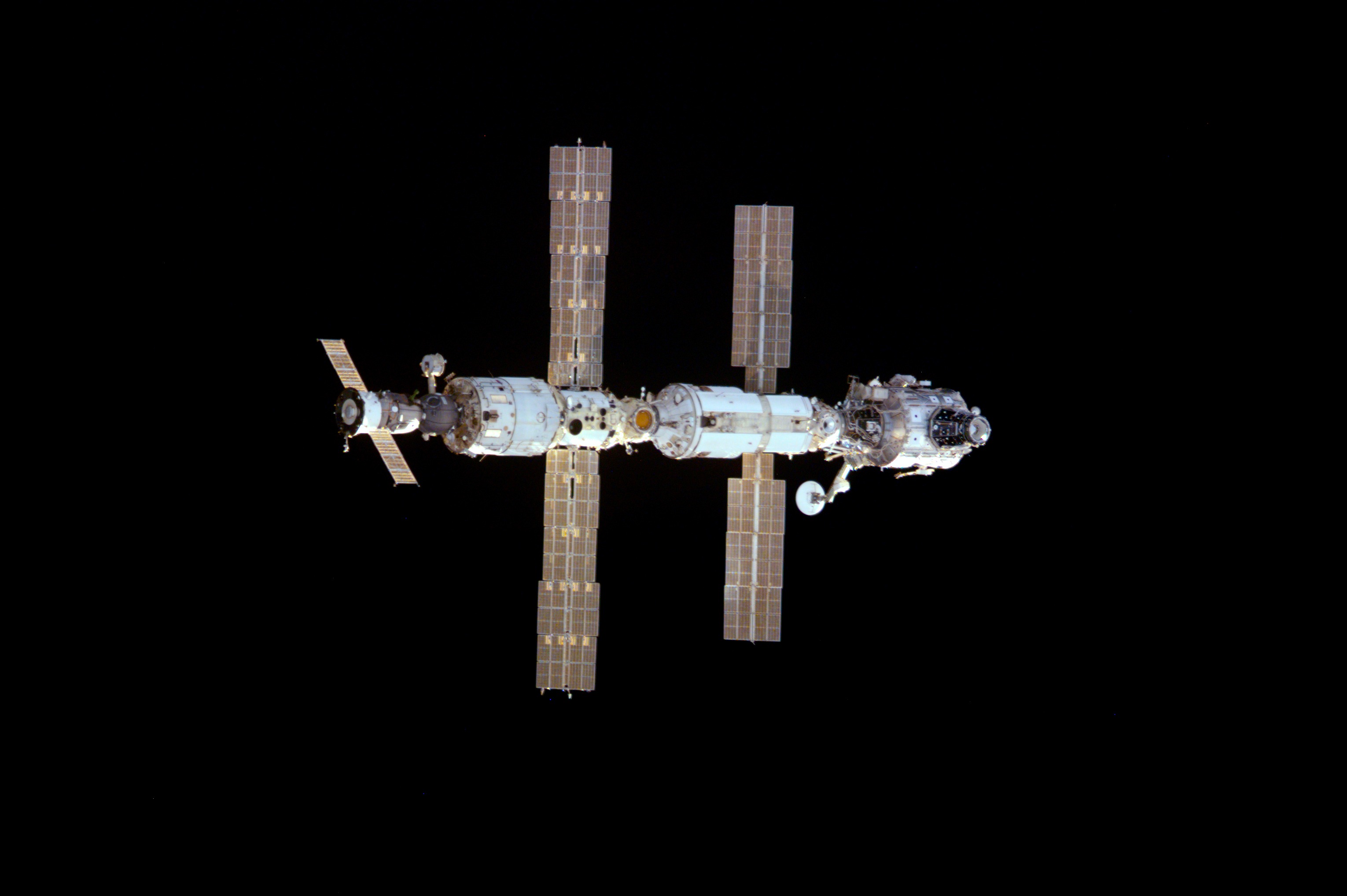
STS-97 on Endeavour arrived on December 2, 2000, and brought up the first two solar panels for the station’s massive Integrated Truss System. This large installation was done by the Endeavour’s crew, requiring three EVAs. A hatch between the station and the shuttle was closed until the work was done, taking almost a week. Once the solar arrays were installed, the hatch was opened, both crews structurally tested the new configuration, and at long last, opened the hatch to Node 1, which had been closed off from entry because there was not enough power to heat it.
The crew of the shuttle brought even more supplies on board the station and then undocked on December 9.
The next visitor for Expedition 1 was STS-98, arriving on February 8, 2001. Atlantis brought a major component of the ISS, the U.S. Lab, officially called Destiny.
Installing Destiny took some reconfiguration. One of the station’s two docking adapters, or PMAs, was moved from the end of Node 1 to the top of the truss temporarily. Then the Lab was moved onto the port recently vacated by the PMA. Then the PMA was put on the end of Destiny, completing the installation.
STS-98 also marked a milestone in station construction. Instead of using reaction control thrusters to maintain the orientation of the complex, ground control switched on the control moment gyros (CMGs) located in the truss on February 13. CMGs are a special type of reaction wheel that doesn’t need to be desaturated because they constantly spin. They change spacecraft orientation by being moved side to side instead of being sped up and slowed down like a reaction wheel.
Reaction wheels need to be periodically desaturated, or slowed down, once they’ve sped up to max speed. This involves firing a thruster in the opposite direction of the spin. Not having to use thrusters to change the station’s attitude or desaturate reaction wheels saves propellant.
The rest of STS-98’s time at the station was spent doing three EVAs to attach the new lab more permanently to the station, including routing power and data cables on the outside to their spots on Destiny and installing handrails and other components to make moving around the station easier on future spacewalks.
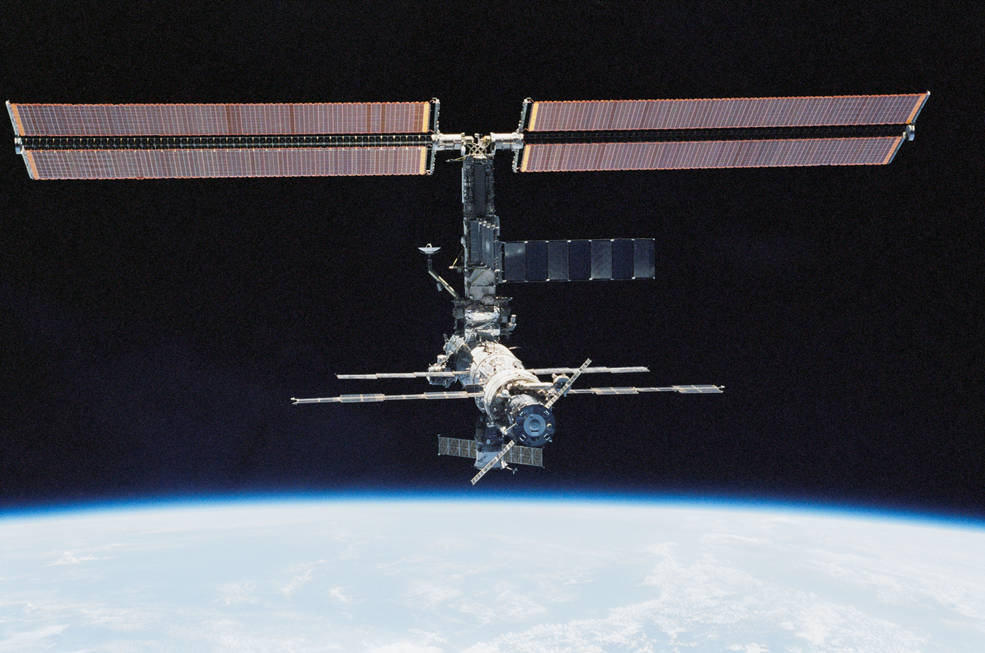
After STS-98, another Progress spacecraft, Progress M44, brought up several tons of supplies to the station and docked to the port that M1-4 had departed the previous month. The Expedition 1 crew unloaded the Progress and packed its supplies into the station.
The final Shuttle to visit Expedition 1, STS-102, arrived on March 10, 2001. Since its primary mission was to swap out crews, no new permanent modules were brought up on this trip. It did, however, do something new: it attached the first Multipurpose Logistics Module to the ISS.
All four modules were named after famous Italians, with this particular module bearing the name Leonardo. The Multipurpose Logistics Module was designed to be brought up with supplies and loaded with experiment samples and other things to be brought back to Earth. For the return trip, it would be put back into the Shuttle’s payload bay. It was attached to Node 1 and was unloaded by the combined crew of ten, a record at the time.
The crew of STS-102 also did two EVAs: one to again move the PMA to allow Leonardo to be berthed and the other to add some components to the station’s truss to prepare for the CanadaArm which was to come.
Discovery undocked on March 19, 2001, leaving Expedition 2 with James Voss, Yury Usachev, and Susan Helms on the ISS.
Statistics
To wrap things up, here’s a running tally of a few spaceflight statistics for the current year:
Toilets currently in space: 7: 4 installed on ISS, 1 on the Soyuz, 1 on the Shenzhou, and 1 on Tianhe.
Total 2021 orbital launch attempts: 110, including 9 failures
Total satellites from launches: 1528
I keep track of orbital launches by where they launched from, also known as spaceport. Here’s that breakdown:

China: 43
USA: 35
Kazakhstan: 10
Russia: 8
French Guinea: 4
New Zealand: 4
India: 2
Japan: 2
Iran: 1
South Korea: 1
Your random space fact is the patch for the MultiPurpose Logistics Module depicts a Teenage Mutant Ninja Turtle in a NASA spacesuit. NASA was able to have this patch made by giving its copyright to the studio that owns the character. It is a very cool patch.
This has been the Daily Space.
You can find more information on all our stories, including images, at DailySpace.org. As always, we’re here thanks to the donations of people like you. If you like our content, please consider joining our Patreon at Patreon.com/CosmoQuestX.
Credits
Hosts: Erik Madaus
Writers: Gordon Dewis, Pamela Gay, Erik Madaus, and Annie Wilson
Audio and Video Editing: Ally Pelphrey
Content Editing: Beth Johnson
Executive Producer: Pamela Gay
Intro and Outro music by Kevin MacLeod, https://incompetech.com/music/


 We record most shows live, on Twitch. Follow us today to get alerts when we go live.
We record most shows live, on Twitch. Follow us today to get alerts when we go live.